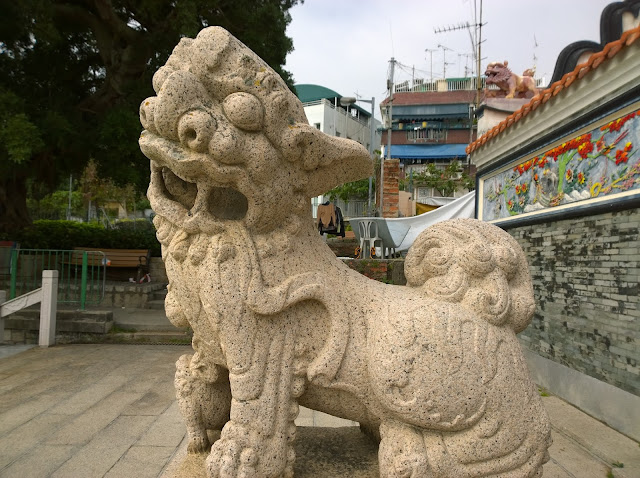If you want a more cultural experience, try checking out one of a few of the temples on Cheung Chau. In today's blog post, I want to take you around the Pak Tai Temple. This is the temple where the famous Cheung Chau Bun Towers are placed every year. I'm not sure about the exact dates of the Cheung Chau Bun Festival, but it always seems like it is in the month of May.
The Pak Tai Temple is located to the left of the Cheung Chau ferry pier. When you exit the ferry, take a left on the main street and keep walking along the waterfront. You will see the basketball court and temple on your right. I think it is about a 10 minute casual walk from the ferry pier.
This temple is so well maintained. The tiling on the roof and even the ornamentation along the walls are beautiful.
The temple faces the water, which seems appropriate as the temple was constructed for the Taoist god of the sea. There is an awesome website that has a lot of information on the temples around Hong Kong: Chinese Temples Committee.
That website is where I got most of my background information about the Cheung Chau Pak Tai Temple.
Similar to a lot of the temples around Hong Kong, the Pak Tai temple was constructed in honor of the god of the seas. Because a lot of the early Cheung Chau residents were fishermen or had work on the seas, they would seek the protection of Pak Tai.
Fun Fact: The temple was constructed in 1783 after a plague broke out on the island. The plague subsided after the image of Pak Tai was brought to the island. It was seen as an omen. So, after that, the Cheung Chau people built the temple in honor of Pak Tai.
I spent a good portion of my time in awe of all the ornamentation that adorns the main entranceway of the temple. I'm not sure about what the images are projecting, but I sort of wonder if it tells the story of the construction of the temple.
Going inside the temple is quite a lovely experience. It was quiet and serene and people walked through with reverence. I love how temples and churches do that to people. There is just a sense of needing to be quiet and respectful when going through anything quite sacred.
The main area of the temple is where a lot of patrons pay homage, pray, and burn incense.
To the left and the right of the main temple area are the side halls.
I really love the fragrance that the coil incense gives off. It's not as overwhelming as those of Hong Kong island's Man Mo Temple, but it is still quite lovely.
Behind the three halls is a courtyard area, which is really just as peaceful and serene as the temple itself. It's a nice little place to sit and reflect on the beauty of the temple.
The next two images are of one of the side halls. The rooms were empty when I was exploring, but it was really nice to see the detailing on the sliding doors unclose. The work it went into carving out these flowers on the door panels is just amazing.
The mosaic in the foyer area was also amazing. So much detail went into the construction of this temple that it leaves me awestruck. I do wish I had more education on the temple though. Like what is the symbolism of this image of the adult tiger and the cub? Is the mosaic telling the story of something? What do the flowers or the birds atop this mosaic symbolize? There is just so much I still have to learn about the wonderful things in life!
I also wonder about the little dragons or lions that are set in front of temples. I wonder if they are guardians who safe guard the temple deity. I just love the sentiment that goes into the construction of sacred places.
To the left of the temple sits a huge tree, which I wonder if it is symbolic of anything taoist. It totally makes me think of when we biked around Yuen Long awhile ago and we stumbled upon the Temple Under A Big Tree.
It's always nice to see something more cultural when visiting Hong Kong. I feel like a lot of the things that are easily accessible to people are the shops and the food. There are a lot of tourist designated spots that are more cultural, like the Big Buddha on Lantau, the Man Mo Temple in Sheung Wan, or the temple with 10,000 Buddhas in Shatin…which are more popular…
But, there are also some cultural things that you can find just walking around randomly…like little temples tucked away on the back streets of some districts…
There is always something wonderful and interesting to find!





















